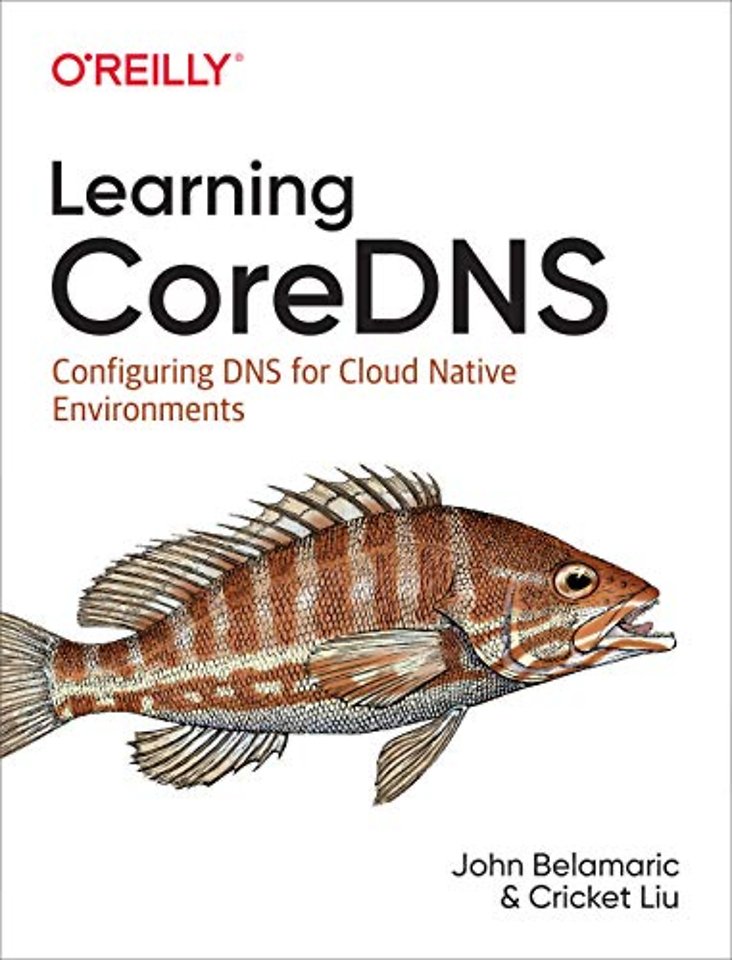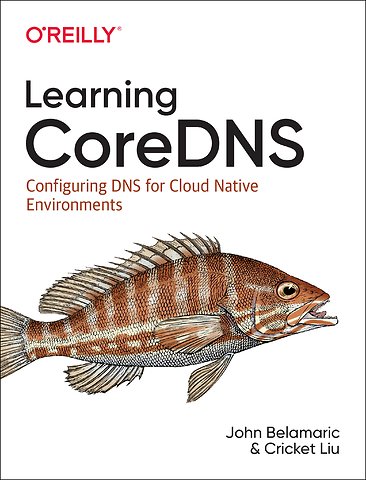


John Belamaric is an experienced software engineer and architect with over 20 years of software design and development experience.
Meer over de auteursLearning CoreDNS
Configuring DNS for Cloud Native Environments
Paperback Engels 2019 1e druk 9781492047964Samenvatting
Until recently, learning CoreDNS required reading the code or combing through the skimpy documentation on the website. No longer. With this practical book, developers and operators working with Docker or Linux containers will learn how to use this standard DNS server with Kubernetes.
John Belamaric, senior staff software engineer at Google, and Cricket Liu, chief DNS architect at Infoblox, show you how to configure CoreDNS using real-world configuration examples to achieve specific purposes. You’ll learn the basics of DNS, including how it functions as a location broker in container environments and how it ties into Kubernetes.
- Dive into DNS theory: the DNS namespace, domain names, domains, and zones
- Learn how to configure your CoreDNS server
- Manage and serve basic and advanced zone data with CoreDNS
- Configure CoreDNS service discovery with etcd and Kubernetes
- Learn one of the most common use cases for CoreDNS: the integration with Kubernetes
- Manipulate queries and responses as they flow through the plug-in chain
- Monitor and troubleshoot the availability and performance of your DNS service
- Build custom versions of CoreDNS and write your own plug-ins
Specificaties
Lezersrecensies
Over Cricket Liu
Inhoudsopgave
Why a New DNS Server?
Who Needs CoreDNS?
Who This Book Is For
What You Will Learn
Conventions Used in This Book
Using Code Examples
O’Reilly Online Learning
How to Contact Us
Acknowledgments
1. Introduction
What Is CoreDNS?
CoreDNS, Containers, and Microservices
CoreDNS Limitations
CoreDNS, Kubernetes, and the Cloud Native Computing Foundation
2. A DNS Refresher
What Is the Domain Name System?
Domain Names and the Namespace
Domains, Delegation, and Zones
Resource Records
DNS Servers and Authority
Resolvers
Resolution and Recursion
Caching
Resource Records
NAME
TTL
CLASS
Resource Record Types
The A Record
The AAAA Record
The CNAME Record
The MX Record
The NS Record
The SRV Record
The PTR Record
The SOA Record
An Annotated Zone Data File
3. Configuring CoreDNS
Getting CoreDNS
CoreDNS Command-Line Options
Corefile Syntax
Environment Variables
Reusable Snippets
Import
Server Blocks
Query Processing
Plug-ins
Root
File
Secondary
Forward
Cache
Errors
Log
Common Configuration Options
fallthrough
tls
transfer to
Sample DNS Server Configurations
Caching-Only DNS Server
Primary DNS Server
Secondary DNS Server
4. Managing Zone Data
The file Plug-in
The auto Plug-in
Using the auto Plug-in with Git
The hosts Plug-in
The route53 plug-in
5. Service Discovery
Introduction to Service Discovery
Solving the Service Discovery Problem
Service Discovery with CoreDNS and etcd
The etcd Plug-in
Other Service Discovery Options
Service Discovery and Container Orchestration
6. Kubernetes
Basic Concepts
Kubernetes Networking
Cluster IP Services
Headless Services
Kubernetes DNS Specification
CoreDNS Integration
Default Configuration
Stub Domains and Federations
Cluster DNS Deployment Resources
Role-Based Access Control
Service
Deployment
Autoscaling
A Better Configuration
The kubernetes Plug-in
CoreDNS Extensions
Pod Options
Wildcard Queries
Autopath and the Dreaded ndots:5
Zone Transfer Support
Exposing Services Externally
Modifying the Available Records
7. Manipulating Queries and Responses
The template Plug-in
The rewrite Plug-in
Using the rewrite Plug-in for EDNS0 Options
Multiple rewrite Rules
The metadata Plug-in
Signing Responses with the DNS Security Extensions
Managing a DNSSEC-Signed Primary Zone
On-the-Fly DNSSEC Signing with the dnssec Plug-in
Case Study: Infoblox’s BloxOne Threat Defense
Identifying Users
Applying Policy
8. Monitoring and Troubleshooting
The prometheus Plug-in
The log Plug-in
The dnstap Plug-in
The errors Plug-in
The trace Plug-in
The debug Plug-in
9. Building a Custom Server
Compiling CoreDNS with an External Plug-in
Building Using Docker
Building on Your Workstation
Modifying plugin.cfg
Replacing main
Writing a Custom Plug-in
There Can Be Only One
Integrating with Metrics, Trace, and Metadata
Index
Anderen die dit boek kochten, kochten ook
Rubrieken
- advisering
- algemeen management
- coaching en trainen
- communicatie en media
- economie
- financieel management
- inkoop en logistiek
- internet en social media
- it-management / ict
- juridisch
- leiderschap
- marketing
- mens en maatschappij
- non-profit
- ondernemen
- organisatiekunde
- personal finance
- personeelsmanagement
- persoonlijke effectiviteit
- projectmanagement
- psychologie
- reclame en verkoop
- strategisch management
- verandermanagement
- werk en loopbaan





